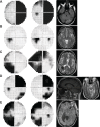Homonymous hemianopia: challenges and solutions
- PMID: 25284978
- PMCID: PMC4181645
- DOI: 10.2147/OPTH.S59452
Homonymous hemianopia: challenges and solutions
Abstract
Stroke is the most common cause of homonymous hemianopia (HH) in adults, followed by trauma and tumors. Associated signs and symptoms, as well as visual field characteristics such as location and congruity, can help determine the location of the causative brain lesion. HH can have a significant effect on quality of life, including problems with driving, reading, or navigation. This can result in decreased independence, inability to enjoy leisure activities, and injuries. Understanding these restrictions, as well as the management options, can aid in making the best use of remaining vision. Treatment options include prismatic correction to expand the remaining visual field, compensatory training to improve visual search abilities, and vision restoration therapy to improve the vision itself. Spontaneous recovery can occur within the first months. However, because spontaneous recovery does not always occur, methods of reducing visual disability play an important role in the rehabilitation of patients with HH.
Keywords: hemianopia; homonymous hemianopia; perimetry; visual field defects; visual training.
Figures



References
-
- Zhang X, Kedar S, Lynn MJ, et al. Homonymous hemianopia in stroke. J Neuroophthalmol. 2006;26(3):180–183. - PubMed
-
- O’Neill EC, Connell PP, O’Connor JC, et al. Prism therapy and visual rehabilitation in homonymous visual field loss. Optom Vis Sci. 2011;88(2):263–268. - PubMed
-
- Gilhotra JS, Mitchell P, Healey PR, et al. Homonymous visual field defects and stroke in an older population. Stroke. 2002;33(10):2417–2420. - PubMed
-
- Zhang X, Kedar S, Lynn MJ, et al. Homonymous hemianopias: clinical-anatomic correlations in 904 cases. Neurology. 2006;66(6):906–910. - PubMed
Publication types
LinkOut - more resources
Full Text Sources
Other Literature Sources
Medical

